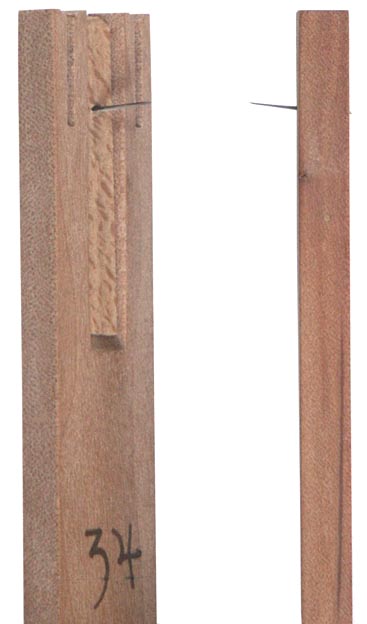The quills

Most books and encyclopaedias on harpsichord construction indicate that the quill projects horizontally from the jack. However, I have never seen a single historical instrument in which this is the case (and I have seen quite a few!). Normally the tongue itself (see the left-hand photo above) is positioned in the jack at a slight angle to the vertical so that the top of the tongue leans back in the jack body at an angle of about 1-2°. In addition the quill and its slot are angled upwards to the horizontal in the tongue itself. In Ruckers instruments this angle is very large and is of the order of 10° to 12°. But in most historical instruments this angle is closer to 5° to 6°.
This angling of the quill has a number of significant consequences. Probably the most important is that, after plucking the string, the quill will always slide past the string on its return. The weight of the jack suspended from the angled quill has a strong component which pushes the quill and tongue back allowing the quill to 'escape' over the string. This ensures that the quills and jacks do not hang on the strings as may sometimes happen with quills which are perfectly horizontal. This is consistent with the general importance which seems to have been placed by the historical makers on reliability in the action of their instruments.
Angling the quill upwards also affects the reliability of the action in another more subtle way. When a key is depressed and the jack begins to rise, the angled quill draws the jack toward the string. Thus, regardless of the amount of play between the jack and the sides of the jackslot, the jack always comes into the same position relative to the string before it plucks the string. The amount of 'bite' of the quill is therefore constant. This is, of course, not the case with horizontal quills which will project under the string by a different amount each time the key is depressed depending on the amount of play between the jack and the sides of the jackslot. The resulting uneven plucking is especially noticeable in the playing of trills or ornaments.
The reliability produced by angling the quill can also affect the voicing of the instrument in a further way that affects the tonal quality in a significant way. Since the quill automatically adjusts the position of the jack relative to the string, one may safely have less quill projecting beyond the string and still be certain that the string will be plucked in a consistent manner. The amount of quill left projecting beyond the string is one of the important factors adjusted during voicing and probably the most important factor affecting the final sound of the instrument which can be controlled by the voicing process. If a large amount of quill projects past the string, the quill displaces the string sideways as well as vertically and the string is released vibrating in a plane angled to the vertical. This effect is generally recognised as being detrimental to the sound produced (clearly only the vertical component of the string's vibration can be radiated by the bridges and soundboard), and thus the smaller the sideways displacement of the string the closer its plane of vibration will be to the vertical. The more the string vibrates in a vertical plane the more up-and-down movement will be transmitted to the soundboard. In this way the maximum amount of the string's energy will be communicated to the air surrounding the instrument. The angling of the quill aids this effect since only by angling the quill can one increase the vertical displacement in the plucking process without increasing the sideways movement of the string as well. Although there is no indication of how the historical makers may have actually voiced their quills, these were certainly both long and angled upwards, and these are features which are recognised today as contributing both to good voicing and a pleasing sound, and also most importantly to the production of a reliable action.
Go back to the main page of this section